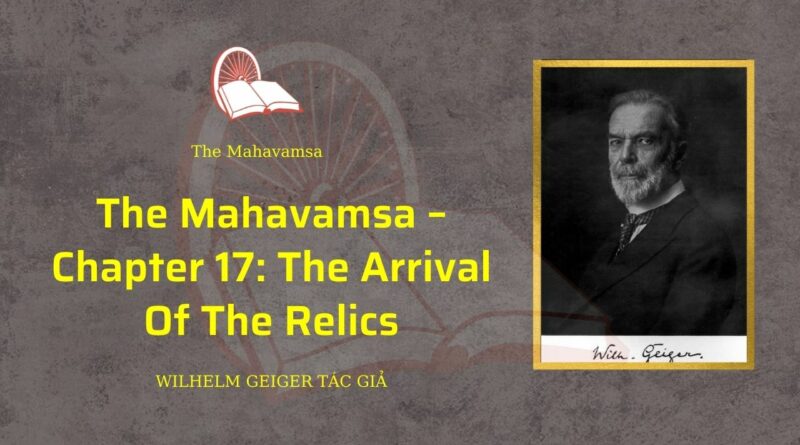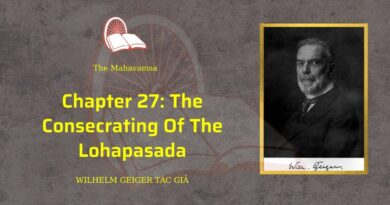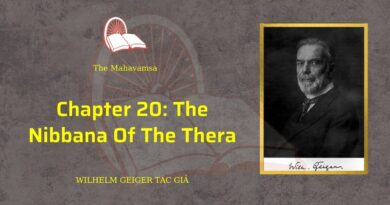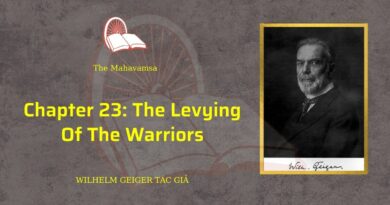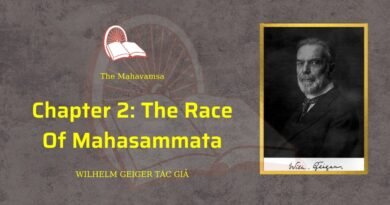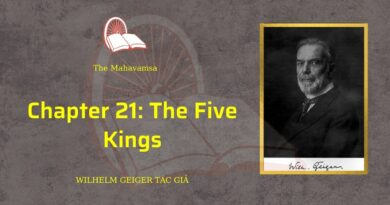THE MAHAVAMSA – CHAPTER 17: THE ARRIVAL OF THE RELICS
WHEN the great thera of lofty wisdom, after spending the rain-season (thus), had held the pavarana-ceremony, on the full-moon day of the month Kattika, he spoke thus to the king: ‘Long is the time, O lord of men, since we have seen the Sambuddha. We lived a life without a master. There is nothing here for us to worship.’ And to the question: ‘Yet hast thou not told me, sir, that the Sambuddha is passed into nibbana?’ he answered: ‘If we behold the relics we behold the Conqueror.’ ‘My intention to build a thupa is known to you. I will build the thupa, and do you discover the relics.’ The thera replied to the king: ‘Take counsel with Sumana’; and the king said to the samanera: ‘Whence shall we have the relics?’ ‘O lord of men, when thou hast commanded the adorning of the city and the road and hast taken the uposathavows upon thyself together with thy company, go thou, in the evening, mounted on thy state-elephant, bearing the white parasol and attended by musicians, to the Mahanaga-park. There, O king, wilt thou receive relics of him who knew how to destroy the elements of existence,’so said the sämanera Sumana to the (king), glad of heart.
And now the thera went forth from the king’s house to the Cetiya-mountain and summoned the samanera Sumana, bent on holy thoughts.’ ‘Go, friend Sumana, and when thou art come to the fair Pupphapura, deliver to the mighty king, thy grandfather, this charge from us: “Thy friend, O great king, the great king, the friend of the gods, desires, being converted to the doctrine of the Buddha, to build a thupa; do thou give him the relies of the Sage and the alms-bowl that the Master used, for many relies of the (Buddha’s) body are with thee.” When thou hast received the alms-bowl full (of relics) go to the fair city of the gods and declare to Sakka, king of the gods, this charge from us: “The relic, the right eye-tooth of the (Buddha), worthy of the adoration of the three worlds, is with thee, O king of the gods, and the relic of the right collar-bone. Honour thou the tooth; the collar-bone of the Master do thou give away. Grow not weary of thy duty toward the isle of Lankä, O lord of the gods!
And the sämanera of wondrous power, replying: ‘So be it, sir,’ went, that very moment, to the king Dhammäsoka and found him even as he stood at the foot of a säla-tree and honoured the beautiful and sacred Bodhi-tree with the offerings of the Kattika-festival.
When he had delivered the thera’s charge and had accepted the alms-bowl full of relics received from the king he went to the Himalaya. When, on the Himalaya, he had set down that most sacred bowl with the relies, he went to the king of the gods and delivered the thera’s charge.
Sakka, the lord of the gods, took from the Culamani-cetiya the right collar-bone (of the Buddha) and gave it to the samanera. Thereupon the ascetic Sumana took the relic and the bowl with the relics likewise and returning to the Cetiya mountain he handed them to the thera.
In the evening the king, at the head of the royal troops, went to the Mahanaga-park, in the manner (already) told. The thera put all the relics down there on the mountain, and therefore the Missaka-mountain was called the Cetiya mountain.
When the thera bad put the vessel with the relics on the Cetiya-mountain, he took the collar-bone relic and went with his company of disciples to the appointed place.
‘If this is a relic of the Sage then shall my parasol bow down, of itself, my elephant shall sink upon its knees, this relic-urn, coming (toward me) with the relic shall descend upon my head.’ So thought the king, and as he thought so it came to pass. And as if sprinkled with ambrosia the monarch was full of joy, and taking (the urn) from his head he set it on the back of the elephant.
Then did the elephant trumpet joyfully and the earth quaked. And the elephant turned about and having entered the fair city by the east gate, together with the theras and the troops and vehicles, and having left it again by the south gate he went to the building, of the Great Sacrifice set up’ to the west of the spot where (afterwards) the cetiya of the Thuparama and when he had turned around on the place of the Bodhi-tree he remained standing, his head turned toward the east.
But at that time the place of the thüpa was covered with flowering kadamba-plants and adari-creepers.
When the god among men had caused this holy place, protected by the gods, to be cleared and adorned, he began forthwith, in seemly wise, to take the relic down from the elephant’s back. But this the elephant would not suffer, and the king asked the thera what he wished. And the other answered: ‘He would fain have (them) put in a place that is equal (in height) to his back; therefore will he not suffer them to be taken down.’
Then with lumps of dry clay that he had commanded to be brought straight way from the dried Abhaya-tank he raised a pile even as (high as the elephant), and when the king had caused this high-standing place to be adorned in manifold ways and had caused the relic to be taken down from the back of the elephant, he placed it there.
(Then) having entrusted the elephant with the guarding of the relic and having left him there, the king, whose heart was set on building a thupa for the relic, and who speedily commanded many people to make bricks, went back with his ministers to the city meditating (to hold) a solemn festival for the relic. But the great thera Mahinda went with his company of disciples to the beautiful Mahamegha-grove and rested there.
During the night the elephant paced around the place with the relic; through the day he stood with the relic in the hail on the spot (destined) for the Bodhi-tree. When the monarch, obedient to the thera’s wish, had built up3 the thüpa knee-high above that (brick)work and had caused the (festival of the) laying down of the relic to be proclaimed in that same place, he went thither and from this region and that, from every side a multitude assembled there.
Amid this assembly the relic rose up in the air from the elephant’s back, and floating in the air plain to view, at the height of seven talas, throwing the people into amazement, it wrought that miracle of the double appearances,’ that caused the hair (of the beholders) to stand on end, even as (did) the Buddha under the Gandamba-tree. By the rays of light and streams of water pouring down therefrom was the whole land of Lanka illumined and flooded again and again.
When the Conqueror lay stretched upon the couch of the great nibbana the five great resolutions were formed by him, who was endowed with the five eyes.
‘The south branch of the great Bodhi-tree, grasped by Asoka, being detached of itself, shall place itself in a vase. When it is so placed the branch, illumining all the regions of the world, shall put forth lovely rays of six colours from its fruits and leaves. Then, rising up with the golden vase, this delightful (tree) shall abide invisible for seven days in the region of snow. My right collar-bone, if it be laid in the Thuparama, shall rise in the air and perform the miracle of the double appearances. If my pure relics, filling a doiameasure, are laid in the Hemamalika-cetiya, that ornament of Lanka, they shall take the form of the Buddha, and rising and floating in the air, they shall take their place after having wrought the miracle of the double appearances.’
Thus did the Tathagata form five resolutions and therefore was the miracle then wrought by the relic. Coming down from the air it rested on the head of the monarch, and full of joy the king laid it in the cetiya. So soon as the relic was laid in the cetiya a wondrous great earthquake came to pass, causing a thrill (of awe). Thus are the Buddhas incomprehensible, and incomprehensible is the nature of the Buddhas, and incomprehensible is the reward of those who have faith in the incomprehensible.
When the people saw the miracle they had faith in the Conqueror. But the prince Mattabhaya, the king’s younger brother, who had faith in the King of Sages, begged leave of the king of men and received the pabbajja of the doctrine with a thousand of his followers.
And from Cetavigama and also from Dvaramandala and also from Viharabahu even as from Gallakapitha and from Upatissagama, from each of these there received gladly the pabajja five hundred young men in whom faith in the Tathagata had been awakened.
So all these who, (coming) from within the city and without (the city), had received the pabbajja of the Conqueror’s doctrine now numbered thirty thousand bhikkhus.
When the ruler of the earth had completed the beautiful thüpa in the Thuparama he caused it to be worshipped perpetually with gifts of many jewels and so forth. The women of the royal household, the nobles, ministers, townspeople, and also all the country-folk brought each their offerings.
And here the king founded a vihara, the thiipa of which had been built before; for that reason this vihära was known by the name Thüpärama.
Thus by these relics of his body the Master of the World, being already passed into nibbana, truly bestowed salvation and bliss in abundance on mankind. How can there be discourse (of this, as it was) when the Conqueror yet lived

